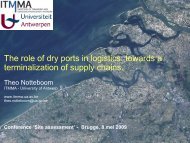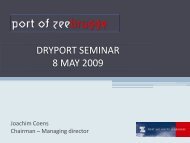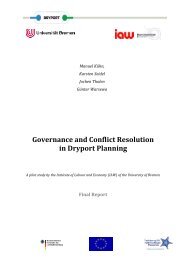the development of hinterland transport by rail - Dryport
the development of hinterland transport by rail - Dryport
the development of hinterland transport by rail - Dryport
- No tags were found...
Create successful ePaper yourself
Turn your PDF publications into a flip-book with our unique Google optimized e-Paper software.
THE DEVELOPMENT OF HINTERLAND<br />
TRANSPORT BY RAIL<br />
-THE STORY OF SCANDINAVIA<br />
Rickard Bergqvist, Ph.D. Assistant Pr<strong>of</strong>essor<br />
Logistics and Transport Research Group, Department <strong>of</strong> Business Administration<br />
School <strong>of</strong> Business, Economics and Law, Go<strong>the</strong>nburg University<br />
P.O. Box 610, SE 405 30 Göteborg, Sweden<br />
Phone +46 31 786 5241 (+46 730 290087)<br />
E-mail: rickard.bergqvist@handels.gu.se<br />
http://www.handels.gu.se/fek/logistikgruppen/<br />
1
Rail <strong>transport</strong> in Europe<br />
• Traditionally relatively weak growth<br />
• About 15% <strong>of</strong> all inland freight <strong>transport</strong>s<br />
Percentage share <strong>of</strong> each mode <strong>of</strong> <strong>transport</strong> in total inland <strong>transport</strong><br />
expressed in tonne-kilometres (tkm). Source: EUROSTAT 2006<br />
Increasing this share has been a<br />
political goal for decades!<br />
•Pollution<br />
•Congestion<br />
•Infrastructure<br />
•Accidents 2
Combined (road-<strong>rail</strong>) <strong>transport</strong> in<br />
EU<br />
• About 5% <strong>of</strong> all freight <strong>transport</strong><br />
• Weak growth<br />
INTERMODAL TRAFFIC OF THE RAILWAYS OF THE EU (15 + NORWAY AND<br />
SWITZERLAND) (IN MILLIONS OF TONNES). SOURCE: Debrie & Gouvernal 2006 3
TRENDS<br />
TRENDS<br />
•<br />
• Increased international trade<br />
• Outsourcing<br />
• Bigger and more effective sea vessels<br />
• Increased containerisation<br />
• Harmonisation <strong>of</strong> <strong>rail</strong> infrastructure<br />
• Privatisation <strong>of</strong> <strong>rail</strong> markets<br />
• Congestion on roads<br />
• Environmental impact<br />
(internalisation <strong>of</strong> external costs)<br />
Sweden<br />
Source: SIKA (2009), Bantrafik 2009<br />
The <strong>development</strong> <strong>of</strong> <strong>hinterland</strong> <strong>transport</strong> <strong>by</strong> means <strong>of</strong> road-<strong>rail</strong><br />
intermodality and contemporary issues!<br />
4
Rail Shuttles<br />
• DryPorts<br />
– Rotterdam, Hamburg, Le Havre, Marseille, Port <strong>of</strong><br />
Göteborg<br />
• Operators<br />
– Maritime: Shipping lines and ports/terminal<br />
operators<br />
– Traction providers<br />
• Regional centralisation and traffic concentration to<br />
principal gateways<br />
Maersk Line (ERS), >250 Departures per<br />
weel, >1000 TEU/day<br />
(http://www.ers<strong>rail</strong>.com)<br />
5
Rail Shuttle System (Port <strong>of</strong><br />
Go<strong>the</strong>nburg)<br />
25<br />
Number <strong>of</strong> actors/locations<br />
>9<br />
Number <strong>of</strong> operators<br />
9<br />
New shuttles<br />
17%<br />
Annual Growth<br />
50%<br />
Marketshare<br />
6
Rail Shuttle system (Port <strong>of</strong><br />
Go<strong>the</strong>nburg)<br />
The Port <strong>of</strong> Go<strong>the</strong>nburg <strong>rail</strong> shuttle<br />
system as <strong>of</strong> May 2009. (Source: Port <strong>of</strong><br />
Go<strong>the</strong>nburg, 2009).<br />
7
Cost-efficiency<br />
• Present system <strong>of</strong> containerized <strong>rail</strong> shuttle<br />
services connected to port <strong>of</strong> Göteborg<br />
Annual<br />
turnover<br />
Business economic<br />
cost savings compared<br />
to direct road<br />
Socio-economic cost<br />
savings compared to<br />
direct road<br />
Employment<br />
$67.000.000 $6.700.000 $8.700.000 390<br />
Part <strong>of</strong> <strong>the</strong> system Share (%)<br />
Port <strong>of</strong> Göteborg 30%<br />
<strong>Dryport</strong> (Terminals) 32%<br />
Traindrivers 38%<br />
Total 100%<br />
8
Environmental Performance<br />
• Currently in <strong>the</strong> EU more than 20% <strong>of</strong> greenhouse gas emissions<br />
(CO 2 ) comes from <strong>the</strong> <strong>transport</strong> sector (Source: Eurostat)<br />
• Road <strong>transport</strong> accounts for more than 90% <strong>of</strong> greenhouse gas<br />
emissions (CO 2 ) in EU (Source: Eurostat)<br />
• Environmental performance <strong>of</strong> <strong>the</strong> present system <strong>of</strong> <strong>rail</strong> shuttle<br />
services connected to port <strong>of</strong> Göteborg:<br />
Annual decrease in emissions compared to direct road:<br />
C0 2 (ton) NOx (kg) HC (kg) CO (kg) PM (kg) SO 2 (kg)<br />
-42 542 -322 970 -47 945 -40 673 -6 098 -2 628<br />
9
Cost-efficiency<br />
-In <strong>the</strong> future<br />
Socio-economic costs savings<br />
Scenario<br />
x10<br />
S3<br />
S5<br />
S4<br />
S2<br />
S1<br />
10% increase in pr<strong>of</strong>itability compared to direct road<br />
10% annual growth on existing <strong>rail</strong> shuttles<br />
4 new <strong>rail</strong> shuttles annually<br />
15% increase in pr<strong>of</strong>itability compared to direct road<br />
10% annual growth on existing <strong>rail</strong> shuttles<br />
2 new <strong>rail</strong> shuttles annually<br />
10% increase in pr<strong>of</strong>itability compared to direct road<br />
10% annual growth on existing <strong>rail</strong> shuttles<br />
2 new <strong>rail</strong> shuttles annually<br />
5% increase in pr<strong>of</strong>itability compared to direct road<br />
10% annual growth on existing <strong>rail</strong> shuttles<br />
4 new <strong>rail</strong> shuttles annually<br />
0% increase in pr<strong>of</strong>itability compared to direct road<br />
5% annual growth on existing <strong>rail</strong> shuttles<br />
2 new <strong>rail</strong> shuttles annually<br />
10
Environmental Performance<br />
- In <strong>the</strong> future<br />
• 0,3-0,7% decrease <strong>of</strong> Sweden's total CO 2 emissions<br />
• Based on EU goal to decrease <strong>by</strong> 20% compared to 1990 level<br />
this would achieve one twentieth <strong>of</strong> <strong>the</strong> goal for Sweden<br />
CO2 reductions (ton)<br />
x10<br />
11
Future <strong>development</strong><br />
• Establishments related to Dry ports<br />
• Dry port functions and services<br />
• T<strong>rail</strong>ers<br />
• Tenders! Market consolidation<br />
• Intelligent system setups<br />
– Coordinating and consolidating shuttles<br />
– Balancing capacity<br />
– Inter regional shuttles!<br />
• Specialisation: T<strong>rail</strong>ers/Containers, Reefers, 3pl<br />
• Ramp freight<br />
• Railferries<br />
• Efficient haulage<br />
12
Conclusions<br />
Currently very interesting <strong>development</strong> related to<br />
Dry ports and:<br />
•Tenders<br />
•Mergers and Acquisitions<br />
•Specialization<br />
•Business models<br />
13







